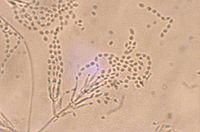
Photo from wikipedia
The Bacillus velezensis GJ-7 strain isolated from the rhizosphere soil of Panax notoginseng showed high nematicidal activity and therefore has been considered a biological control agent that could act against… Click to show full abstract
The Bacillus velezensis GJ-7 strain isolated from the rhizosphere soil of Panax notoginseng showed high nematicidal activity and therefore has been considered a biological control agent that could act against the root-knot nematode Meloidogyne hapla. However, little was known about whether the GJ-7 strain could produce volatile organic compounds (VOCs) that were effective in biocontrol against M. hapla. In this study, we evaluated the nematicidal activity of VOCs produced by the fermentation of GJ-7 in three-compartment Petri dishes. The results revealed that the mortality rates of M. hapla J2s were 85% at 24 h and 97.1% at 48 h after treatment with the VOCs produced during GJ-7 fermentation. Subsequently, the VOCs produced by the GJ-7 strain were identified through solid-phase micro-extraction gas chromatography mass spectrometry (SPME-GC/MS). Six characteristic VOCs from the GJ-7 strain fermentation broth were identified, including 3-methyl-1-butanol, 3-methyl-2-pentanone, 5-methyl-2-hexanone, 2-heptanone, 2,5-dimethylpyrazine, and 6-methyl-2-heptanone. The in vitro experimental results from 24-well culture plates showed that the six volatiles had direct-contact nematicidal activity against M. hapla J2s and inhibition activity against egg hatching. In addition, 3-methyl-1-butanol and 2-heptanone showed significant fumigation effects on M. hapla J2s and eggs. Furthermore, all six of the VOCs repelled M. hapla J2 juveniles in 2% water agar Petri plates. The above data suggested that the VOCs of B. velezensis GJ-7 acted against M. hapla through multiple prevention and control modes (including direct-contact nematicidal activity, fumigant activity, and repellent activity), and therefore could be considered as potential biocontrol agents against root-knot nematodes.
Journal Title: Molecules
Year Published: 2023
Link to full text (if available)
Share on Social Media: Sign Up to like & get
recommendations!